Business Decision Analytics | Assignment
VerifiedAdded on 2022/08/20
|6
|1476
|14
AI Summary
Contribute Materials
Your contribution can guide someone’s learning journey. Share your
documents today.
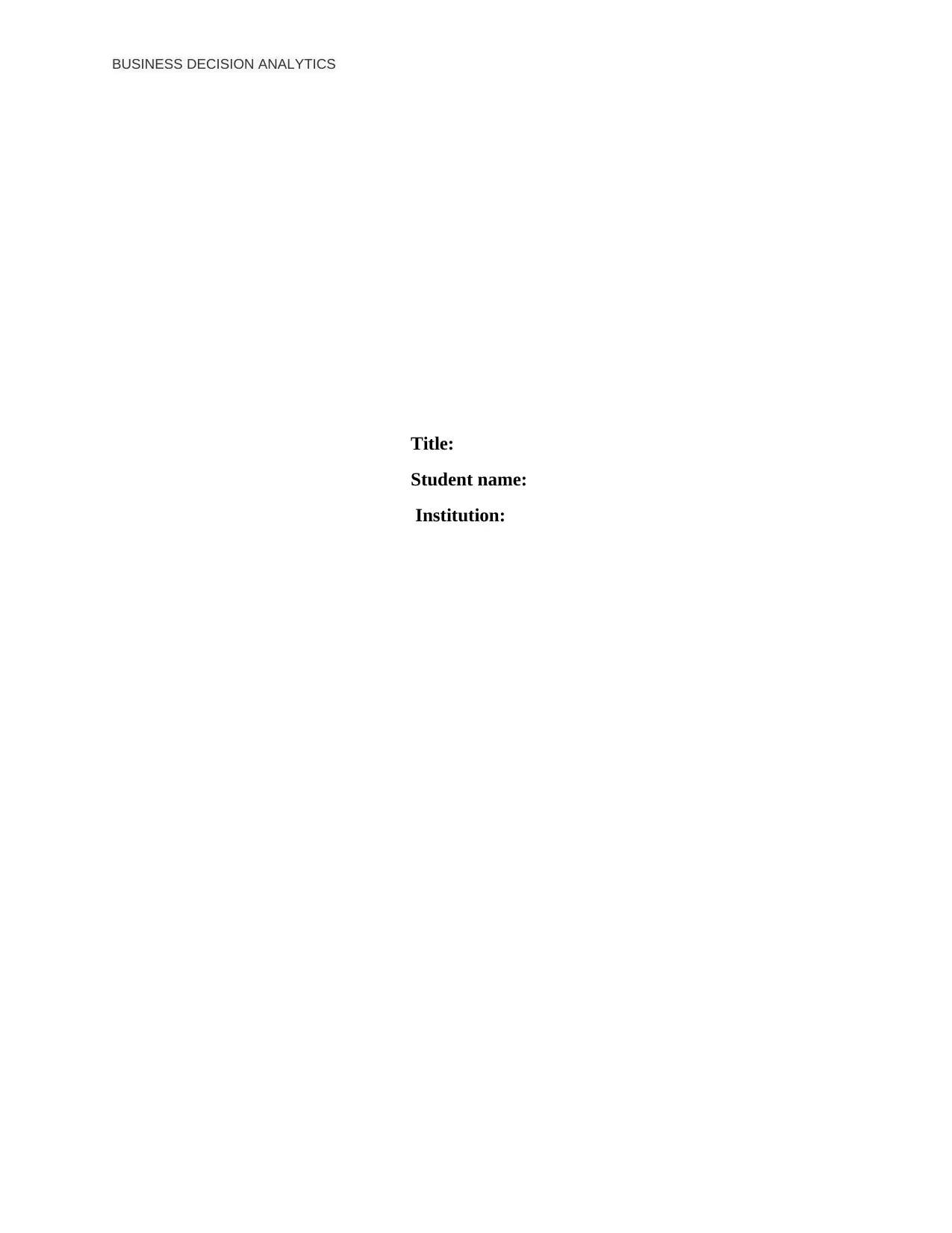
BUSINESS DECISION ANALYTICS
Title:
Student name:
Institution:
Title:
Student name:
Institution:
Secure Best Marks with AI Grader
Need help grading? Try our AI Grader for instant feedback on your assignments.
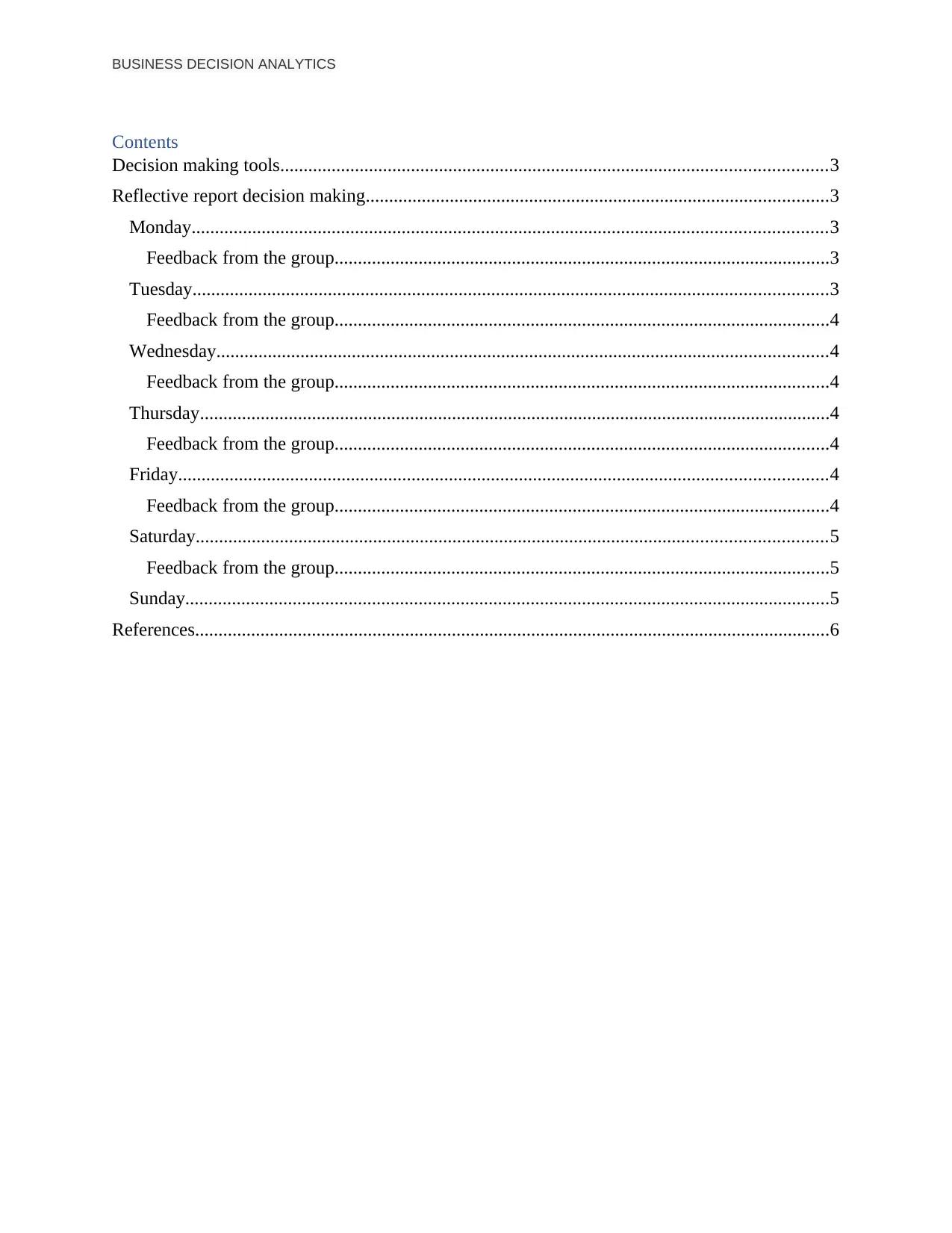
BUSINESS DECISION ANALYTICS
Contents
Decision making tools.....................................................................................................................3
Reflective report decision making...................................................................................................3
Monday........................................................................................................................................3
Feedback from the group..........................................................................................................3
Tuesday........................................................................................................................................3
Feedback from the group..........................................................................................................4
Wednesday...................................................................................................................................4
Feedback from the group..........................................................................................................4
Thursday.......................................................................................................................................4
Feedback from the group..........................................................................................................4
Friday...........................................................................................................................................4
Feedback from the group..........................................................................................................4
Saturday.......................................................................................................................................5
Feedback from the group..........................................................................................................5
Sunday..........................................................................................................................................5
References........................................................................................................................................6
Contents
Decision making tools.....................................................................................................................3
Reflective report decision making...................................................................................................3
Monday........................................................................................................................................3
Feedback from the group..........................................................................................................3
Tuesday........................................................................................................................................3
Feedback from the group..........................................................................................................4
Wednesday...................................................................................................................................4
Feedback from the group..........................................................................................................4
Thursday.......................................................................................................................................4
Feedback from the group..........................................................................................................4
Friday...........................................................................................................................................4
Feedback from the group..........................................................................................................4
Saturday.......................................................................................................................................5
Feedback from the group..........................................................................................................5
Sunday..........................................................................................................................................5
References........................................................................................................................................6
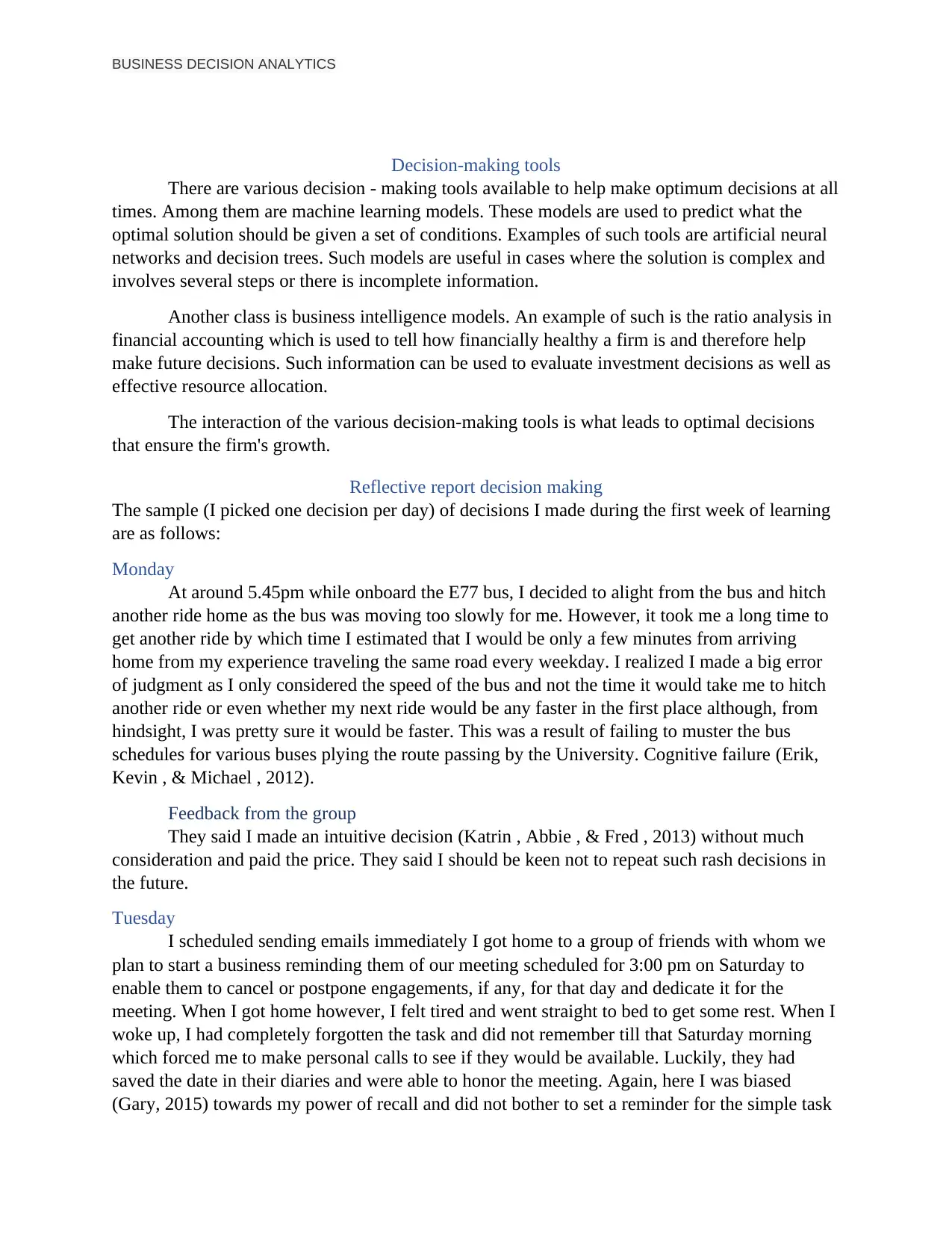
BUSINESS DECISION ANALYTICS
Decision-making tools
There are various decision - making tools available to help make optimum decisions at all
times. Among them are machine learning models. These models are used to predict what the
optimal solution should be given a set of conditions. Examples of such tools are artificial neural
networks and decision trees. Such models are useful in cases where the solution is complex and
involves several steps or there is incomplete information.
Another class is business intelligence models. An example of such is the ratio analysis in
financial accounting which is used to tell how financially healthy a firm is and therefore help
make future decisions. Such information can be used to evaluate investment decisions as well as
effective resource allocation.
The interaction of the various decision-making tools is what leads to optimal decisions
that ensure the firm's growth.
Reflective report decision making
The sample (I picked one decision per day) of decisions I made during the first week of learning
are as follows:
Monday
At around 5.45pm while onboard the E77 bus, I decided to alight from the bus and hitch
another ride home as the bus was moving too slowly for me. However, it took me a long time to
get another ride by which time I estimated that I would be only a few minutes from arriving
home from my experience traveling the same road every weekday. I realized I made a big error
of judgment as I only considered the speed of the bus and not the time it would take me to hitch
another ride or even whether my next ride would be any faster in the first place although, from
hindsight, I was pretty sure it would be faster. This was a result of failing to muster the bus
schedules for various buses plying the route passing by the University. Cognitive failure (Erik,
Kevin , & Michael , 2012).
Feedback from the group
They said I made an intuitive decision (Katrin , Abbie , & Fred , 2013) without much
consideration and paid the price. They said I should be keen not to repeat such rash decisions in
the future.
Tuesday
I scheduled sending emails immediately I got home to a group of friends with whom we
plan to start a business reminding them of our meeting scheduled for 3:00 pm on Saturday to
enable them to cancel or postpone engagements, if any, for that day and dedicate it for the
meeting. When I got home however, I felt tired and went straight to bed to get some rest. When I
woke up, I had completely forgotten the task and did not remember till that Saturday morning
which forced me to make personal calls to see if they would be available. Luckily, they had
saved the date in their diaries and were able to honor the meeting. Again, here I was biased
(Gary, 2015) towards my power of recall and did not bother to set a reminder for the simple task
Decision-making tools
There are various decision - making tools available to help make optimum decisions at all
times. Among them are machine learning models. These models are used to predict what the
optimal solution should be given a set of conditions. Examples of such tools are artificial neural
networks and decision trees. Such models are useful in cases where the solution is complex and
involves several steps or there is incomplete information.
Another class is business intelligence models. An example of such is the ratio analysis in
financial accounting which is used to tell how financially healthy a firm is and therefore help
make future decisions. Such information can be used to evaluate investment decisions as well as
effective resource allocation.
The interaction of the various decision-making tools is what leads to optimal decisions
that ensure the firm's growth.
Reflective report decision making
The sample (I picked one decision per day) of decisions I made during the first week of learning
are as follows:
Monday
At around 5.45pm while onboard the E77 bus, I decided to alight from the bus and hitch
another ride home as the bus was moving too slowly for me. However, it took me a long time to
get another ride by which time I estimated that I would be only a few minutes from arriving
home from my experience traveling the same road every weekday. I realized I made a big error
of judgment as I only considered the speed of the bus and not the time it would take me to hitch
another ride or even whether my next ride would be any faster in the first place although, from
hindsight, I was pretty sure it would be faster. This was a result of failing to muster the bus
schedules for various buses plying the route passing by the University. Cognitive failure (Erik,
Kevin , & Michael , 2012).
Feedback from the group
They said I made an intuitive decision (Katrin , Abbie , & Fred , 2013) without much
consideration and paid the price. They said I should be keen not to repeat such rash decisions in
the future.
Tuesday
I scheduled sending emails immediately I got home to a group of friends with whom we
plan to start a business reminding them of our meeting scheduled for 3:00 pm on Saturday to
enable them to cancel or postpone engagements, if any, for that day and dedicate it for the
meeting. When I got home however, I felt tired and went straight to bed to get some rest. When I
woke up, I had completely forgotten the task and did not remember till that Saturday morning
which forced me to make personal calls to see if they would be available. Luckily, they had
saved the date in their diaries and were able to honor the meeting. Again, here I was biased
(Gary, 2015) towards my power of recall and did not bother to set a reminder for the simple task
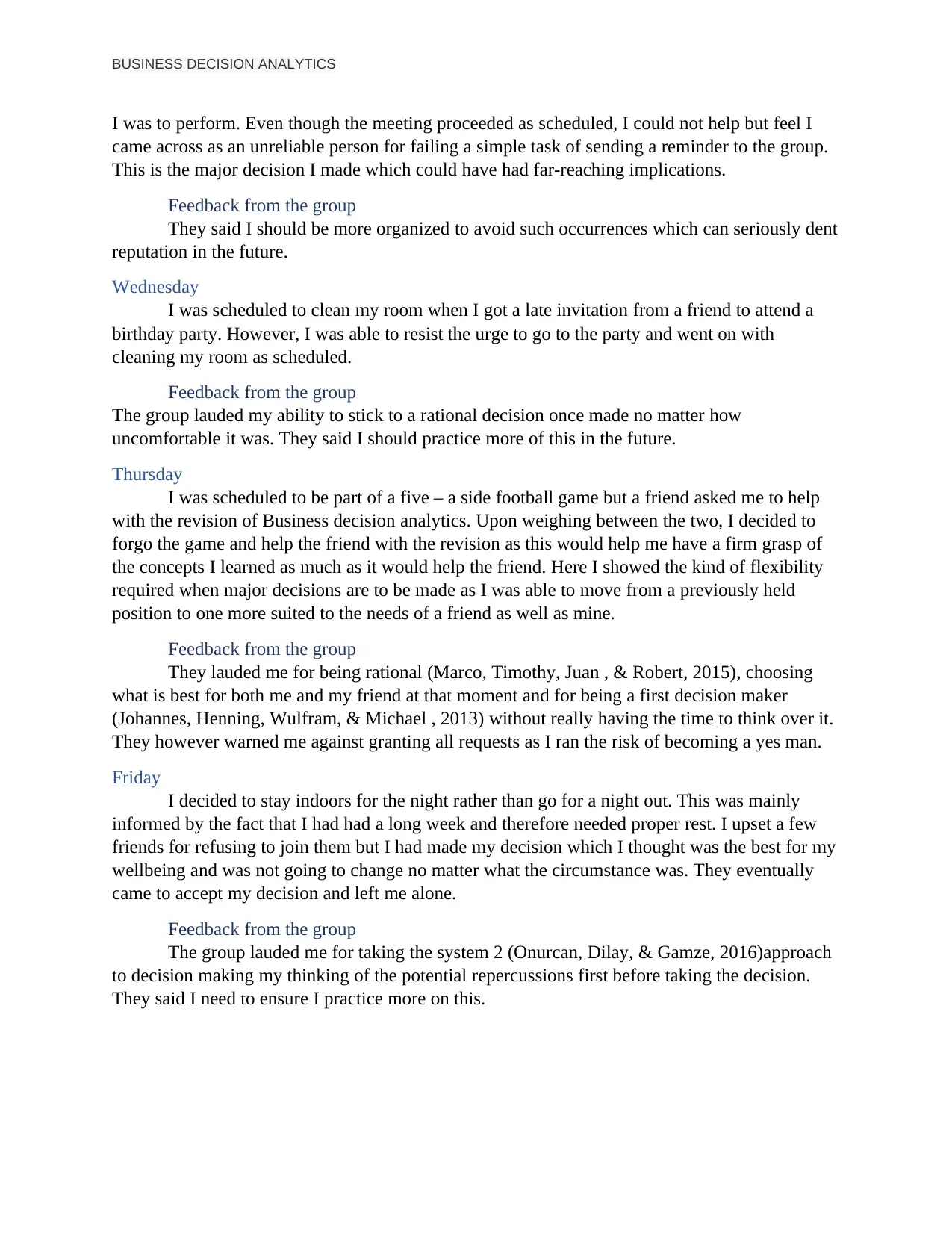
BUSINESS DECISION ANALYTICS
I was to perform. Even though the meeting proceeded as scheduled, I could not help but feel I
came across as an unreliable person for failing a simple task of sending a reminder to the group.
This is the major decision I made which could have had far-reaching implications.
Feedback from the group
They said I should be more organized to avoid such occurrences which can seriously dent
reputation in the future.
Wednesday
I was scheduled to clean my room when I got a late invitation from a friend to attend a
birthday party. However, I was able to resist the urge to go to the party and went on with
cleaning my room as scheduled.
Feedback from the group
The group lauded my ability to stick to a rational decision once made no matter how
uncomfortable it was. They said I should practice more of this in the future.
Thursday
I was scheduled to be part of a five – a side football game but a friend asked me to help
with the revision of Business decision analytics. Upon weighing between the two, I decided to
forgo the game and help the friend with the revision as this would help me have a firm grasp of
the concepts I learned as much as it would help the friend. Here I showed the kind of flexibility
required when major decisions are to be made as I was able to move from a previously held
position to one more suited to the needs of a friend as well as mine.
Feedback from the group
They lauded me for being rational (Marco, Timothy, Juan , & Robert, 2015), choosing
what is best for both me and my friend at that moment and for being a first decision maker
(Johannes, Henning, Wulfram, & Michael , 2013) without really having the time to think over it.
They however warned me against granting all requests as I ran the risk of becoming a yes man.
Friday
I decided to stay indoors for the night rather than go for a night out. This was mainly
informed by the fact that I had had a long week and therefore needed proper rest. I upset a few
friends for refusing to join them but I had made my decision which I thought was the best for my
wellbeing and was not going to change no matter what the circumstance was. They eventually
came to accept my decision and left me alone.
Feedback from the group
The group lauded me for taking the system 2 (Onurcan, Dilay, & Gamze, 2016)approach
to decision making my thinking of the potential repercussions first before taking the decision.
They said I need to ensure I practice more on this.
I was to perform. Even though the meeting proceeded as scheduled, I could not help but feel I
came across as an unreliable person for failing a simple task of sending a reminder to the group.
This is the major decision I made which could have had far-reaching implications.
Feedback from the group
They said I should be more organized to avoid such occurrences which can seriously dent
reputation in the future.
Wednesday
I was scheduled to clean my room when I got a late invitation from a friend to attend a
birthday party. However, I was able to resist the urge to go to the party and went on with
cleaning my room as scheduled.
Feedback from the group
The group lauded my ability to stick to a rational decision once made no matter how
uncomfortable it was. They said I should practice more of this in the future.
Thursday
I was scheduled to be part of a five – a side football game but a friend asked me to help
with the revision of Business decision analytics. Upon weighing between the two, I decided to
forgo the game and help the friend with the revision as this would help me have a firm grasp of
the concepts I learned as much as it would help the friend. Here I showed the kind of flexibility
required when major decisions are to be made as I was able to move from a previously held
position to one more suited to the needs of a friend as well as mine.
Feedback from the group
They lauded me for being rational (Marco, Timothy, Juan , & Robert, 2015), choosing
what is best for both me and my friend at that moment and for being a first decision maker
(Johannes, Henning, Wulfram, & Michael , 2013) without really having the time to think over it.
They however warned me against granting all requests as I ran the risk of becoming a yes man.
Friday
I decided to stay indoors for the night rather than go for a night out. This was mainly
informed by the fact that I had had a long week and therefore needed proper rest. I upset a few
friends for refusing to join them but I had made my decision which I thought was the best for my
wellbeing and was not going to change no matter what the circumstance was. They eventually
came to accept my decision and left me alone.
Feedback from the group
The group lauded me for taking the system 2 (Onurcan, Dilay, & Gamze, 2016)approach
to decision making my thinking of the potential repercussions first before taking the decision.
They said I need to ensure I practice more on this.
Secure Best Marks with AI Grader
Need help grading? Try our AI Grader for instant feedback on your assignments.
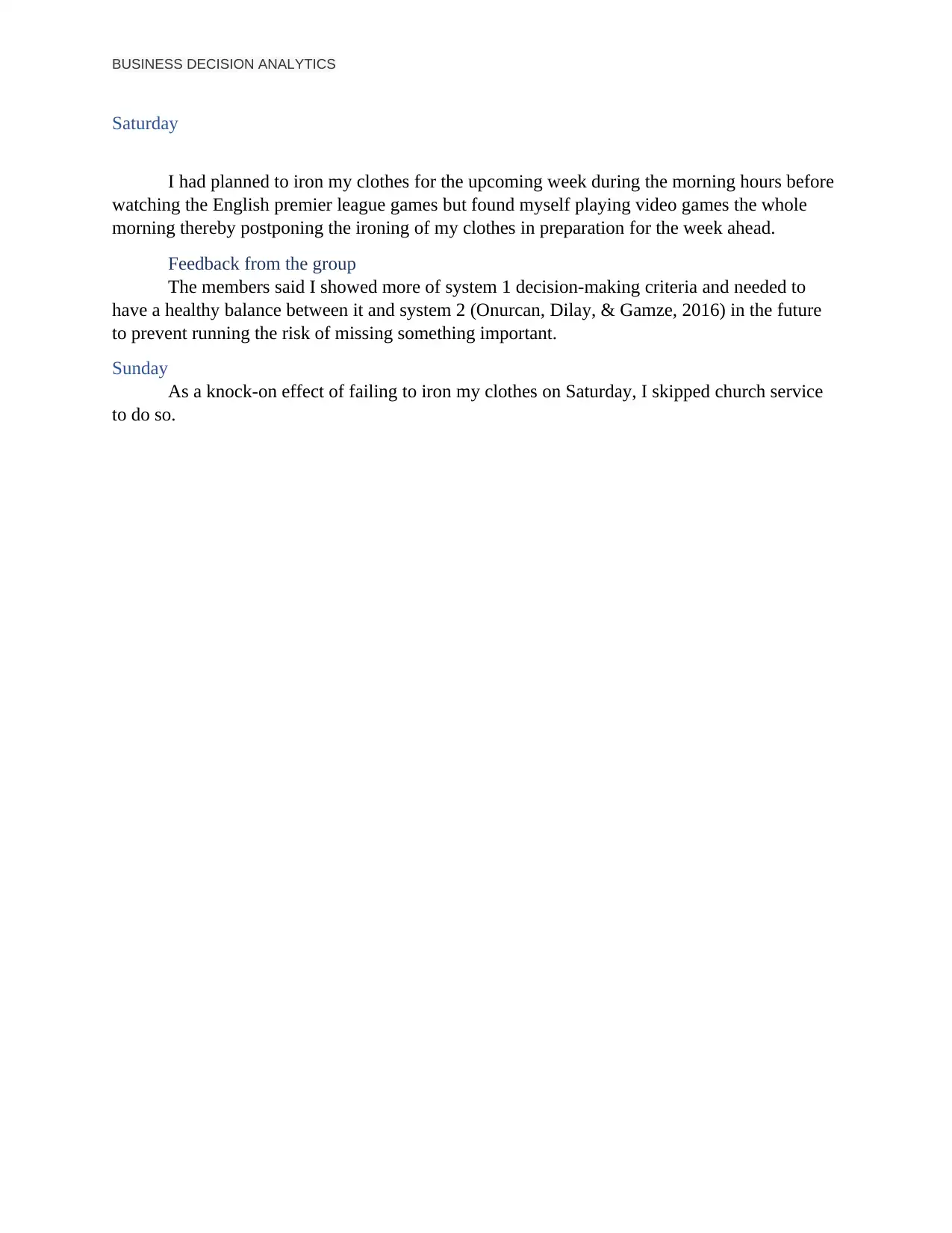
BUSINESS DECISION ANALYTICS
Saturday
I had planned to iron my clothes for the upcoming week during the morning hours before
watching the English premier league games but found myself playing video games the whole
morning thereby postponing the ironing of my clothes in preparation for the week ahead.
Feedback from the group
The members said I showed more of system 1 decision-making criteria and needed to
have a healthy balance between it and system 2 (Onurcan, Dilay, & Gamze, 2016) in the future
to prevent running the risk of missing something important.
Sunday
As a knock-on effect of failing to iron my clothes on Saturday, I skipped church service
to do so.
Saturday
I had planned to iron my clothes for the upcoming week during the morning hours before
watching the English premier league games but found myself playing video games the whole
morning thereby postponing the ironing of my clothes in preparation for the week ahead.
Feedback from the group
The members said I showed more of system 1 decision-making criteria and needed to
have a healthy balance between it and system 2 (Onurcan, Dilay, & Gamze, 2016) in the future
to prevent running the risk of missing something important.
Sunday
As a knock-on effect of failing to iron my clothes on Saturday, I skipped church service
to do so.
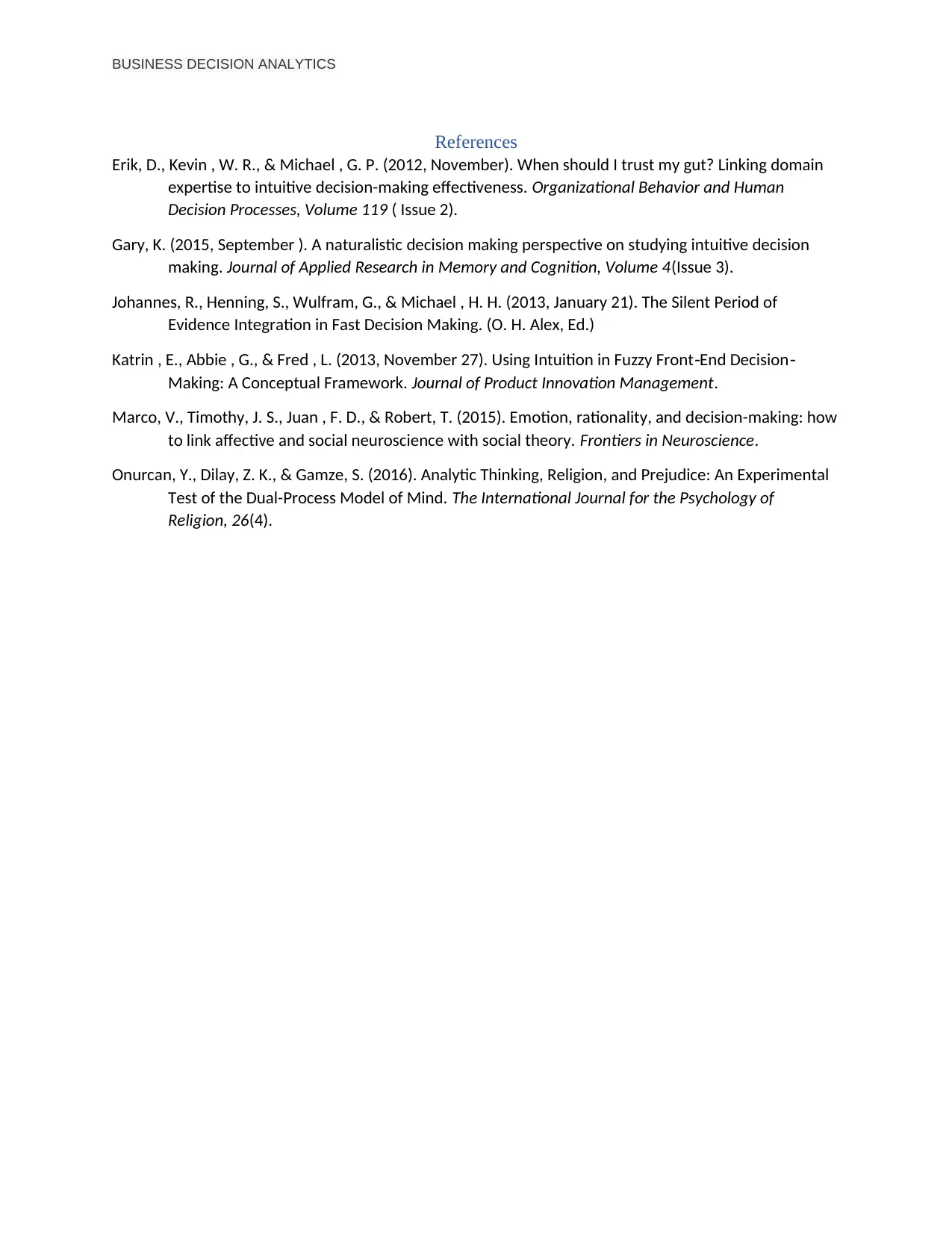
BUSINESS DECISION ANALYTICS
References
Erik, D., Kevin , W. R., & Michael , G. P. (2012, November). When should I trust my gut? Linking domain
expertise to intuitive decision-making effectiveness. Organizational Behavior and Human
Decision Processes, Volume 119 ( Issue 2).
Gary, K. (2015, September ). A naturalistic decision making perspective on studying intuitive decision
making. Journal of Applied Research in Memory and Cognition, Volume 4(Issue 3).
Johannes, R., Henning, S., Wulfram, G., & Michael , H. H. (2013, January 21). The Silent Period of
Evidence Integration in Fast Decision Making. (O. H. Alex, Ed.)
Katrin , E., Abbie , G., & Fred , L. (2013, November 27). Using Intuition in Fuzzy Front End Decision‐ ‐
Making: A Conceptual Framework. Journal of Product Innovation Management.
Marco, V., Timothy, J. S., Juan , F. D., & Robert, T. (2015). Emotion, rationality, and decision-making: how
to link affective and social neuroscience with social theory. Frontiers in Neuroscience.
Onurcan, Y., Dilay, Z. K., & Gamze, S. (2016). Analytic Thinking, Religion, and Prejudice: An Experimental
Test of the Dual-Process Model of Mind. The International Journal for the Psychology of
Religion, 26(4).
References
Erik, D., Kevin , W. R., & Michael , G. P. (2012, November). When should I trust my gut? Linking domain
expertise to intuitive decision-making effectiveness. Organizational Behavior and Human
Decision Processes, Volume 119 ( Issue 2).
Gary, K. (2015, September ). A naturalistic decision making perspective on studying intuitive decision
making. Journal of Applied Research in Memory and Cognition, Volume 4(Issue 3).
Johannes, R., Henning, S., Wulfram, G., & Michael , H. H. (2013, January 21). The Silent Period of
Evidence Integration in Fast Decision Making. (O. H. Alex, Ed.)
Katrin , E., Abbie , G., & Fred , L. (2013, November 27). Using Intuition in Fuzzy Front End Decision‐ ‐
Making: A Conceptual Framework. Journal of Product Innovation Management.
Marco, V., Timothy, J. S., Juan , F. D., & Robert, T. (2015). Emotion, rationality, and decision-making: how
to link affective and social neuroscience with social theory. Frontiers in Neuroscience.
Onurcan, Y., Dilay, Z. K., & Gamze, S. (2016). Analytic Thinking, Religion, and Prejudice: An Experimental
Test of the Dual-Process Model of Mind. The International Journal for the Psychology of
Religion, 26(4).
1 out of 6
Related Documents
Your All-in-One AI-Powered Toolkit for Academic Success.
+13062052269
info@desklib.com
Available 24*7 on WhatsApp / Email
![[object Object]](/_next/static/media/star-bottom.7253800d.svg)
Unlock your academic potential
© 2024 | Zucol Services PVT LTD | All rights reserved.





